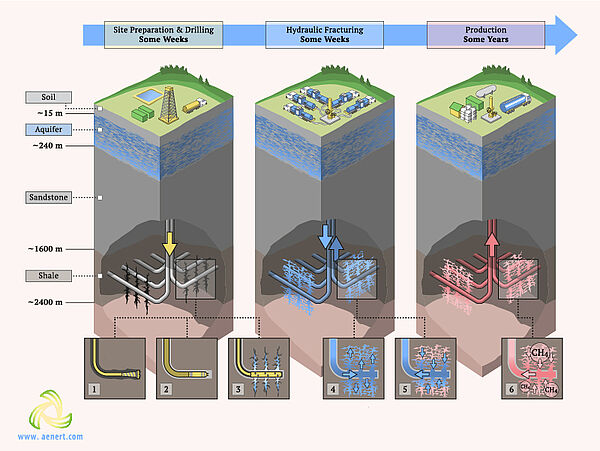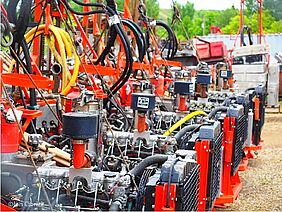Oil and gas production from low permeability plays in most cases requires the employment of directional drilling and hydraulic fracturing technologies. This is necessary to increase the contact area of the well with a formation rich in oil or gas, and to improve the permeability of the rock. Taking into consideration the increase in the share of hard-to-recover reserves in the global hydrocarbon balance, it becomes clear that the use of these technologies will keep steadily growing.
Presently, the ratio of conventional vertical to directional wellbores is shifting towards the latter group in some countries. At the same time, in the real world the costs of directional drilling in average comprise from several hundred to 1.5-2 thousand US dollars per 1 meter, depending on specific objectives and conditions of drilling, thus reaching several million US dollars per wellbore. Costs related to energy necessary to power the drilling machinery comprise a considerable portion of the total expenses in this case, mainly in the form of electric energy, gas, or liquid fuel.
Another key problem of oil and gas production from low-permeability plays employing hydraulic fracturing technologies is high freshwater consumption. Increased water consumption during fracking is determined by the very essence of the technological operation, which is based on hydraulic action. Typically, average freshwater consumption used in hydraulic fracturing starts from 10 million litres per wellbore, but in some cases – considerably more.
Extraction and reutilization of pumped water rarely exceeds 50%, as treating and removal of large volumes of wastewater resulting from hydraulic fracturing is an expensive procedure. As a result, water supply comprises a substantial portion of operating expenses in oil and gas production activities involving hydraulic fracturing, often exceeding 10%. This is particularly important for deposits located in arid regions that are rich in shale hydrocarbons.
In addition to high operational costs, inefficient use of energy, gas or water in directional drilling and hydraulic fracturing operations considerably determines the degree of ecological impact on hydrocarbon extraction regions and, on a global scale – on the environment of the entire planet. In this regard, thorough planning of hydrocarbon production with the involvement of the most recent advances in resource- and energy-saving in directional drilling and hydraulic fracturing technologies is considered as one of the highest-priority tasks in oil and gas industry.
A considerable portion of efficient technical solutions aimed to resolve the problems is concentrated in patent documents registered in various patent offices. However, subject-oriented search, precise selection and systematization of such documents are associated with substantial difficulties of technical, linguistic, and methodological nature. First of all, this is related to the fact that currently neither the existing marking of inventions, nor the search options proposed in patent databases allow a comprehensive and reliable selection of patents and patent applications corresponding to the criteria above to be performed. The proposed original patent database, in which each patent document has undergone a thorough subject-oriented evaluation and was provided with additional semantic markers to the fullest extent reflects the state-of-the-art advancements in the reduction of energy, gas and water consumption in directional drilling and hydraulic fracturing technologies.
The database contains 4566 patent documents registered in patent offices around the world since 1993 that were published in publicly available patent databases, found in the result of a deliberate patent search, and processed in accordance with the methodology by the date of compilation of this database (November 2021).
Each patent document in this database contains a list of conventional bibliographical indicators, including original title, English version of title, family size, application date, publication date, patenting office, names of inventors and applicants, document kind (patent or application), number of claims, number of citing, IPC indices, and core document number.
Also, all documents are provided with additional markers – unified indicators that include: technology categories (indicate the applicability of technical solutions to one of the energy industry sectors, as stated by the authors of the inventions); technology elements (indicators with a specific level of detailing for the production process in a particular energy industry sector); problems (technical, economical, ecological and other problems declared by the authors in a patent document); type of technical solution (device, method, composition).
The database contains several derived indicators, including applicant statuses, residence of applicants, Unified Indicator Group. Indicators such as patent pending period, prominent patents, applicant's share in the aggregate intellectual property register can be calculated based on the available data.
The database also includes statistical analysis for major parameters of patent documents published during the 20-year period between 2001-2020. In particular, the statistical analysis includes a breakdown of documents by publication dates, by patent families, by patent offices, by residents and non-residents, and by applicant countries.
The main body of the patent documents were registered between 2014 and 2020 with a peak of patenting activity in 2017. With rare exceptions, USPTO (US) patent office annually was the leader by the number of granted patents.
The highest activity in patenting their inventions was demonstrated by the residents of the United States with a share of more than 60% of the total number of patents granted during 2001-2020. Among other countries whose residents were granted at least 30 patents were China, Canada, the Netherlands, Saudi Arabia, France, and Russia.
The most popular IPC subgroup with a share of almost 6.1% was E21B43/26 - obtaining fluids from wells by forming crevices or fractures. Different methods as a type of technical solution were mentioned in almost 50% of cases, different devices – in almost 29.5%, while different compositions – in 20.5%. In a considerable part of the inventions two or more types of technical solutions were mentioned simultaneously.
The list of top 10 most productive applicants by the number of patents includes:
Halliburton Energy Services, Inc. (US)
Baker Hughes Incorporated (US)
Schlumberger Technology Corporation (US)
Evolution Well Services, LLC (US)
Saudi Arabian Oil Company (SA)
Tatneft (RU)
Enventure Global Technology (US)
CNPC CCDC Chuanqing Drilling Engineering Company Limited (CN)
Schlumberger Technology B.V. (NL)
Evolution Engineering Inc. (CA)
The proposed patent database allows the existing trends in the intellectual property market of the specified industrial sector to be timely traced, as well as provides the possibility of acquiring a carefully selected list of patent documents fully corresponding to the specified subject. The database is targeted at inventors, engineers, researchers, managers, and business administrators involved in the development of Oil & Gas production technologies from low permeability plays.
